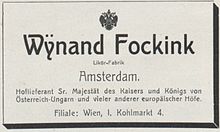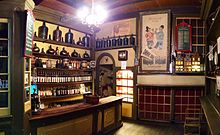Wynand Fockink
Coordinates: 52 ° 22 ′ 20.5 " N , 4 ° 53 ′ 43" E
| Wynand Fockink BV
|
|
|---|---|
| legal form | BV |
| founding | 1679 |
| Seat | Amsterdam |
| Branch | spirits |
| Website | www.Wynand-Fockink.nl |
Wynand Fockink (also spelled Wijnand Fockink ) was an important Dutch manufacturer of spirits , especially genever . The main building was at Pijlsteeg 31 in the center of Amsterdam , today a Fockink Museum and a Proeflokaal ("tasting point") have been set up there.
history
Around 1679 Jan Bierman opened a spirits and liqueur distillery on the Pijlsteeg in Amsterdam. Around 1730 Wynand Fockink (1693–1778) took over the distillery. Wynand married the second time in 1733. Of the many children who came from this connection, only his daughter Maria survived into adulthood, so Wynand had no male offspring. Three years before his death he made Johan Dentzel his business partner.
Under the management of Wynand Fockink, the liqueur distillery became one of the largest in the Netherlands , and his business contacts as a wine merchant made a major contribution to this. Johan Dentzel expanded the company and by the turn of the century the company owned six buildings on Amsterdam's Oudezijds Voorburgwal , along with six other buildings on Pijlsteeg. In the early 19th century, Fockink continued to expand by exporting liqueurs and genever. Fockink opened stores in Berlin, Vienna, Brussels and Paris. France was one of the largest sales markets in the period from 1815 to 1860. Fockink was purveyor to the court of the Queen of the Netherlands, imperial court purveyor and other European courts. The shop there was at the exclusive Kohlmarkt 4 in the 1st district.
The brothers Johannes and Petrus Schmitz, who were both married to Wynand Fockink's great-grandchildren, took over the business in the early 19th century and also ran it successfully. Other buildings in Amsterdam were bought, at which time a passage was built between Damstraat and Pijlsteeg to make the shop, also known as Proeflokaal , more visible.
Around 1870 Fockink had five stills , used a 30 hp -Dampfmaschine and employed about 80 employees. During this time the export to America began. 1920 Fockink was from a family business into a joint stock company transformed limited liability company.
In the years after World War II , Fockink increasingly faced competition from Lucas Bols . In 1954 Bols bought Fockink. The distillery was dismantled and production and trade were now managed from Bols, first from Amsterdam's Rozengracht and later from Nieuw Vennep. Wynand Fockink's products remained on the market until 1970. After the end, a restaurant was operated in the old office building, the tenant was Pieter Gijsberti Hodenpijl from 1948 to autumn 1988. From 1988 to 1993 the house was occupied by squatters. In 1993 Jaros Janssens and Jan Galesloot opened the old commercial building with attached distillery as a museum and information center for liqueurs and genever, in which its history and production are presented to the public. Rob Koning and Paul Wanrooij have been the operators since January 1st, 2008.
Products
In Proeflokaal various liqueurs and gin are offered, including the WF Superior (a three year old Genever), 'Bruidstranen' (a spiced wine was administered before a wedding), 'Hansje in de kelder' s as well as house specialties like 'Half Half 'and' Boswandeling '( forest walk ) that made Fockink famous.
A specialty is the way genever is drunk in the Fockink. Filled in small glasses, the drinker has to bend down to the glass and sip the first sip without using his hands.
literature
- Ingrid Haslinger: Customer - Kaiser. The story of the former imperial and royal purveyors . Schroll, Vienna 1996, ISBN 3-85202-129-4 .



